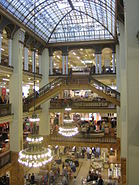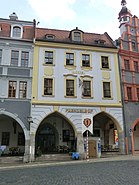Görlitz
- The title of this article contains the character ö. Where it is unavailable or not wanted, the name may be written as Goerlitz.
Görlitz (![]() [ˈɡœɐ̯lɪʦ] (help·info), Upper Sorbian: Zhorjelc, Czech: Zhořelec, Polish: Zgorzelec, Upper Lusatian dialect: Gerlz, Gerltz or Gerltsch) is a town in Germany on the river Lusatian Neisse, in the Bundesland (Federal State) of Saxony, opposite the Polish town of Zgorzelec. Zgorzelec was a part of Görlitz until 1945.
[ˈɡœɐ̯lɪʦ] (help·info), Upper Sorbian: Zhorjelc, Czech: Zhořelec, Polish: Zgorzelec, Upper Lusatian dialect: Gerlz, Gerltz or Gerltsch) is a town in Germany on the river Lusatian Neisse, in the Bundesland (Federal State) of Saxony, opposite the Polish town of Zgorzelec. Zgorzelec was a part of Görlitz until 1945.
Görlitz | |
|---|---|
|
From top: View over Görlitz, inside Görlitz Department Store, Untermarkt (market square), Landeskrone (Sedło) mountain, Upper Lusatian Library of Sciences (Oberlausitzische Bibliothek der Wissenschaften) | |
| Coordinates: 51°09′10″N 14°59′14″E / 51.15278°N 14.98722°E | |
| Country | Germany |
| State | Saxony |
| District | Görlitz |
| Subdivisions | 10 town- and 8 village-quarters |
| Government | |
| • Mayor | Siegfried Deinege |
| Area | |
| • Total | 67.22 km2 (25.95 sq mi) |
| Elevation | 199 m (653 ft) |
| Population (2022-12-31)[1] | |
| • Total | 56,574 |
| • Density | 840/km2 (2,200/sq mi) |
| Time zone | UTC+01:00 (CET) |
| • Summer (DST) | UTC+02:00 (CEST) |
| Postal codes | 02826–02828 |
| Dialling codes | 03581 |
| Vehicle registration | GR |
| Website | www |
Historically Görlitz has belonged at times to the regions of Lusatia and Silesia. Today it is the easternmost city in Germany.
History
changeWhen Nazi Germany lost the war, German troops blew up all bridges crossing the Lusatian Neisse. The redrawing of boundaries in 1945 – in particular the relocation of the German-Polish border to the Oder-Neisse line – divided the town, the right bank becoming part of Poland, and named Zgorzelec in 1948, while the main portion became part of the German state of Saxony. When the East German states were dissolved in 1952, Görlitz became part of the Dresden Bezirk (region), but the states were restored upon German reunification in 1990.
Today Görlitz and Zgorzelec, two towns on opposite banks of the river, have friendly relations. Two bridges have been rebuilt, a bus line connects the German and Polish parts of the town, and there is a common urban management, with annual common sessions of both town councils.
On June 27, 1994, the town was became a Roman Catholic diocese.
Görlitz is the hometown of current German football players Michael Ballack and Jens Jeremies.
In 2006 Görlitz/Zgorzelec was a candidate for European City of Culture 2010. It was hoped that the jury could be convinced by the concept of a Polish-German Cooperation but Essen got the award, with Görlitz achieving the second place. The Campaign was renamed City of Culture to intensify German-Polish relationship and to attract tourists from all over the world.
In fiction
changeThe dramatic courtroom scene, at the conclusion of John le Carré famous Cold War spy novel "The Spy Who Came in from the Cold", takes place in a secret Socialist Unity Party of Germany installation near Görlitz, in the middle 1960s.
People
change- Jakob Böhme - philosopher, 1575 born in a village near Görlitz.
- Johann Christoph Brotze
- Oskar Morgenstern
- Hans-Jürgen Dörner, football player and coach
- Jens Jeremies, retired footballer, had played for Bayern Munich and the German national team.
- Michael Ballack, footballer, signed to German club Bayer Leverkusen, current captain of the German national team.
References
change- ↑ "Einwohnerzahlen nach Gemeinden als Excel-Arbeitsmappe" (XLS) (in German). Statistisches Landesamt des Freistaates Sachsen. 2024.
Other websites
changeMedia related to Görlitz at Wikimedia Commons









